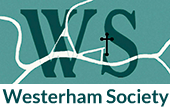The first fire brigade in the UK was formed in the Lothian area of Scotland in 1824. It was to be 20 more years before Westerham had its own brigade – a volunteer force formed by men from the local community. The first fire-fighting appliance was a hand-drawn cart with a hand operated pump and one hose, but by the 1900’s a horse drawn pump was being utilised.
The Great Fire of Westerham
Bill Curtis
From The Herald Newspaper for Saturday July 9: DISASTROUS WESTERHAM FIRE - THREAT TO EAST-END OF TOWN, FIREMEN’S GIGANTIC TASK
…The fire was first discovered by Mr J. Watkins, whose residence, “Stakes” adjoins Mr Evenden’s works. He was about to retire for the night when he was alarmed by a crackling noise, as of burning timber. Looking from a window he at once saw that the motor works were fully ablaze. Realising the danger to his own establishment, he immediately roused the household, and the maids, having hastily thrown wraps over their night attire, raced up the high-street to apprise Mr C. W. Hooker, Captain of the Fire Brigade, whereupon the alarm met with a speedy response. Acting with commendable forethought, Mr Watkins, on discovering the outbreak, immediately had ladders brought from the rear of his premises and placed against the malthouse to enable the Brigade to douse the fire from the roof of his building. Fireman Whitmore hurried to the engine house, and with the assistance of some private individuals raced to the blazing building with the hose cart. By this time Capt. Hooker and the majority of the Brigade were on the spot, and set to work to check the progress of the flames. The fire raged with a fury which it seemed no human power could quell, and dwellers in the vicinity were in a state of mind akin to panic.
The doomed building was like a fiery furnace, from which the leaping flames threatened destruction to all the buildings around. Realising the serious situation, the Captain gave instructions for aid to be summoned from Sundridge and Sevenoaks. Having complete knowledge of the buildings, Mr. Watkins was able to point the Brigade to the most favourable positions from which to attack the fire; and his suggestions were speedily put into practice. The greatest danger emanated from the Town side of the building, adjoining the old brewery malt kiln, and it was towards this spot that the firemen directed unrelenting zeal. Working from three hydrants on high pressure main, the brigade played on the fire with five branches. Fortunately an ample supply of water at tremendous pressure was available; but for a time the fire seemed to defy all efforts. While attention was directed to the Town end, the flames at the opposite end broke out with added vigour, and threatened Stakes Cottages. The flames had reached the gable end of the nearest cottage; but well-directed jets of water drove back the menacing blaze. Efforts were again directed to saving the malt kiln, for it was realised that once this old building had become involved, the fire would have encompassed Mr Watkins’ residence and neighbouring houses, with the inevitable result that they would have been burnt out. But to save the kiln from the ravages of the flames was an exceedingly difficult task, and in the hands of less determined and capable men would never have been accomplished. They spared no effort, and gradually checked the advance of the fire in this direction. The heat was unbearable, but the intrepid firemen stuck to their duty unflinchingly until the fire was subdued. But this was not until six a.m., after five or six hours of the most trying and dangerous duty conceivable.
The Combe Bank Fire Brigade and that of Sevenoaks having been summoned to help, arrived abut three-quarters of an hour from the call, but by that time, neither were really required, as the men of the Westerham Brigade had, by superhuman efforts, got the fire well in-hand. Sevenoaks returned almost immediately, but the Combe Bank men returned after having rendered valuable assistance for a couple of hours.
Eye-witnesses of the scene are not likely to forget the fearful sight the fire presented when raging at it’s height. Flames burst through the roof, doors and windows, and swathed the whole town in a lurid red glare. Its reflection in the sky was seen for miles.
A woman in one of the adjoining cottages heard the crackling sound, and first took no notice, thinking the cadets were out manoeuvring. Later she opened the bedroom window and observing the blaze awakened her husband with the cry “Westerham’s on fire!” The premises destroyed were originally known as the Swan Brewery. When daylight came, the scene was one of indescribable desolation. From the exterior there was visible only the carcass of the building and from the interior charred supports, twisted girders, and the ruins of what the day previous was a valuable motor engineering plant. It was then that the real danger in which the houses around the malthouse had stood was fully realised; and it was impossible to view the scene without marvelling at the pluck and determination of Captain Hooker and his men, who so well succeeded in accomplishing what at first seemed impossible; checking the spread of fire to the neighbouring cottages.







No Comments
Add a comment about this page